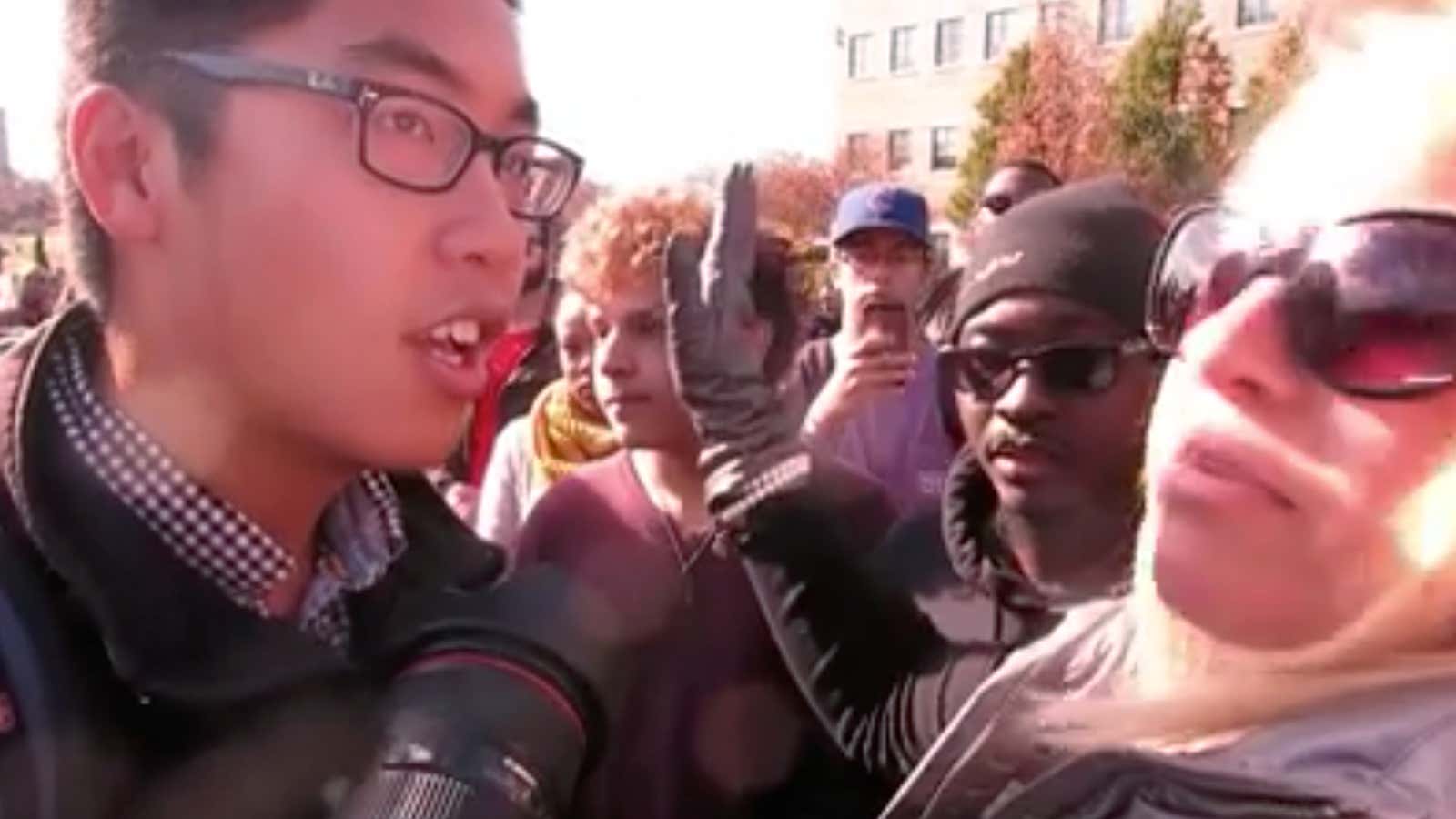In a sentence more frequently waved about than read, even in the United States of America, the First Amendment to the US Constitution declares:
Congress shall make no law respecting an establishment of religion, or prohibiting the free exercise thereof; or abridging the freedom of speech, or of the press; or the right of the people peaceably to assemble, and to petition the Government for a redress of grievances.
If Congress shall make no law abridging the freedom of the press, then do students and professors have the right to abridge it? What happens when the people peaceably assembling interfere with the freedom of the press to get close enough to take their pictures assembling, insisting that journalists are unnecessary and their work theprivilege of an elite caste?
This question was thrown into the national spotlight this week in the wake of a student protest at the Columbia campus of the University of Missouri. Students spearheading the activism were galvanized by a number of racist incidents which, many thought, university president Timothy M. Wolfe and Columbia campus chancellor R. Bowen Loftin failed to take seriously. On Monday, amid a camp-out on the campus lawn, a hunger strike and the football team’s threat to boycott future games, the president and the chancellor resigned.
But what ought to have been a triumphal moment for the protest encampment devolved into an occasion for a much different kind of publicity. With cameras rolling, a phalanx of demonstrators surrounded the little tent city to block out journalists, including a student photographer, Tim Tai, who was physically pushed back. “It’s my right to walk forward,” Tai, on assignment for ESPN.com, argued. He got blocked.
In an interesting detail, an assistant professor of communication, Melissa Click, was clearly overheard calling out to another student photographer, Mark Schierbecker, “You need to get out. You need to get out” and then, after apparently smacking his camera: “Who wants to help me get this reporter out of here? I need some muscle over here.” The muscle did not materialize, but Schierbecker’s video did—on YouTube.
As NYU law professor Burt Neuborne has recently written in his book, Madison’s Music, the rights enumerated in the First Amendment trace “the arc of a democratic idea—from conception to codification.” These rights are bundled. The right to assemble is the right to assemble. The right of the press is the right of the press. They both serve the same public interest: the right to know. The cause may be just or unjust, the press may be approved or disapproved, but democracy thrives on openness and is chewed away by the proliferation of “safe spaces,” meaning, apparently, spaces safe from argument. God preserve us from spaces that banish argument!
As my onetime comrade in Students for a Democratic Society Carl Oglesby memorably put it, “Democracy is nothing if it is not dangerous.” Protesters who turn transparency opaque in a public place presumably do not understand the meaning of “public.” They have commandeered the place—expropriated it, in effect; converted it into their private property.
As the YouTube video circulated online, some on social media came to the activists’ defense. Professor, author and New York Times columnist Roxane Gay tweeted, to much social media approval: “This sense that we are entitled to access and information. We should interrogate that.”
There is plenty to “interrogate,” a term many academics have come to like because it sounds aggressive and makes simple questioning look wimpy. In the aftermath, Click has resigned her courtesy appointment with the Missouri School of Journalism—but not before she received hate mail and rape threats. Meanwhile, the Washington Post reports that “anonymous threats were directed towards students of color.” Such threats are undemocratic in themselves. Intimidation is vile.
Students should feel safe on their campuses, but not at the cost of a lively public life. Indeed, a free press has many times proved its value for safety’s sake. There’s a long history here. For social movements, this is not only a matter of democratic principle, it’s a matter of strategy. Media—even when distorting, invasive, stupid, or politically unsavory—are channels. Without them, much of the civil rights movement would have fallen into a deep hole; the antiwar, women’s, and queer movements likewise.
In the ‘50s and ‘60s, reporting about Southern civil rights actions like the Montgomery bus boycott (1955-56) and the Freedom Rides (1961) was eagerly sought by activists who were trying to puncture a curtain of silence. Atrocity photos galvanized people who didn’t want to face the brutality of the Deep South. (Here, for example, is Jet magazine’s photo of the mangled face of the 14-year-old Chicago boy Emmett Till, beaten to death in Mississippi for allegedly whistling at a white woman.)
TV footage at its best exposed the awfulness of the Vietnam War. When the antiwar movement was open, many press reports gave them credibility even as others accentuated the most garish and outré of the rebels. In the ‘80s, when ACT-UP disrupted government presentations, the press paid attention, and the protesters gained the right to fast-track AIDS drugs. And in 2011, footage of a New York police officer pepper-spraying a peaceful protester rallied support for Occupy Wall Street. None of these images could have circulated if journalists hadn’t been free to go wherever they thought the news was.
When movements block communication—even communication to a public they suspect via channels they disapprove—they harden into echo chambers. That is when the mobs and the czars march in.
It’s the movements that understand this that, in the end, win.
